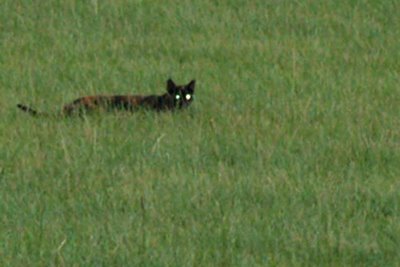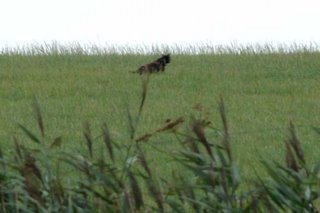The Trigger-Happy Gendarmes in Pas-de-Calais Issue a Death Warrant for Mysterious Black Gros Chat

"God requires that we assist the animals when they need our help."
-- St. Francis of Assisi
Even though they do not even know whether it is a panther or simply an overgrown tabby, the bloodthirsty gendarmes in Pas-de-Calais have nonetheless ordered that a mysterious black gros chat be hunted down and killed. (See photos above and below.)
The cat, which has small rounded ears and a rather long body and tail, was first spotted on a dune in Wissant by an elderly Calaisien on August 9th. Two days later it was sighted again by tourists in a field in Audinghen. The area, located between Cap Gris Nez and Cap Blanc Nez in northeast Pas-de-Calais, is also home to numerous cows, deer, rabbits, and domestic cats.
Regardless of its pedigree, it has not attacked any humans and there have not been any reported fatalities of either livestock or pets in the area. On the occasions when it has been sighted it has quickly disappeared into the woods.
None of this has, however, deterred the politicians and gendarmes from signing its death warrant. At least eighty men (See photo below) and a helicopter were originally deployed in the region in order to track down and kill the cat. Traps baited with chickens also have been used in an attempt to lure the cat out of hiding. The prefecture of Audinghen has even taken the unusual step of declaring the area where the gros chat was spotted to be off-limits to the public.

The authorities initially thought that the mysterious cat had escaped from a circus but that claim has been denied by officials of a local big top. The prevailing opinion amongst experts who have viewed photos of the cat is that it is an overgrown Felis cattus and not a panther.
That new appraisal of the situation coupled with their lack of success in tracking down the cat has prompted the gendarmes to significantly scale back the hunt. According to the August 15th edition of Der Spiegel, only about fifteen of them are still actively searching for the cat but they have vowed to nonetheless remain vigilant. (See "Mysterious Big Cat Sighted in France.")
Big cat sightings are not unheard of in Pas-de-Calais. During the summer of 1986 a cat resembling a panther was spotted in the area but some officials dismissed that claim as a hoax.
Animals thought to be panthers have also been sighted Down Under. For instance, mysterious cats have been sighted off and on for the past five years in Ashburton, New Zealand. A large pawprint and piles of feces discovered last week in an area an hour's drive south of Christchurch have been proven, however, to belong to a dog. (See The Ashburton Guardian, August 22, 2006, "Pawprints (sic) 'Belong to a Dog'.")

In June of last year, a hunter near Sale in the Gippsland section of the Australian state of Victoria shot and killed what he thought was a panther. DNA tests conducted at Monash University in Melbourne later confirmed that it was only a harmless overgrown feral cat. Of course, a cat's pedigree is irrelevant as far as the ailurophobic Cobbers and Kiwis are concerned since they slaughter feral cats by the millions for sport. (See Cat Defender post of January 6, 2006 entitled "DNA Tests Confirm That 'Big Cat' Killed in Australia Was a Feral Tabby and Not a Puma.")
More alarmingly, the cat sighted in Pas-de-Calais may not be either a Felis cattus or a panther. Since domestic cats are currently being bred to wild cats, it is possible that it could be part of a designer breed. (See Cat Defender post of May 19, 2005 entitled "Savannahs: More Feline Cruelty Courtesy of the Capitalists and the Bourgeoisie.")
A clone or some other genetic anomaly are also possibilities. (See Cat Defender post of September 6, 2005 entitled "Clones of Endangered African Wildcats Give Birth to Eight Naturally-Bred Healthy Kittens in New Orleans.") There is so much diabolical animal research being conducted nowadays in university and government laboratories that new and larger species of animals are becoming commonplace.
Like viruses, sometimes these unfortunate animals either escape or are intentionally released into the wild by the mad scientists who have created them. They are then mercilessly hunted down and killed by sportsmen, ranchers, and people who get a kick out of killing animals. Some people believe that the Elmendorf Creature (sometimes referred to as a chupacabra) came from a laboratory but this is mere conjecture.
What is so disturbing about the report out of Pas-de-Calais is that the French's first reaction to the sighting of the cat was to organize a death squad. This is precisely what the Germans did back in June when Bruno became the first grizzly to set foot inside Deutschland since the nineteenth century. (See Cat Defender post of June 30, 2006 entitled "Cheap, Bloodthirsty Bavarians Mercilessly Gun Down First Brown Bear to Visit das Vaterland in 171 Years.")

It really does not make any difference whether the cat sighted in Pas-de-Calais is a panther or a feral cat; it has an inalienable right to go on living regardless of its pedigree. Should it be determined to be a panther, it could easily be either trapped or tranquilized and then relocated to a sanctuary where it could live out its life. This would, however, cost time and money and deprive the gendarmes of their blood sport.
Bridgitte Bardot and other animal rights advocates in France should rush to this cat's defense and let the authorities know in no uncertain terms that killing it will not be tolerated. Sadly, the French media so far have mentioned only an unnamed woman from Namur, Belgium who has appealed to the mayor of Audinghen to spare the cat's precious life. (See La Voix du Nord, August 18, 2006, "La fin des recherches, mais pas du mystere 'panthere'.")
Photos: Philippe Huguen of Agence France Presse (cat) and La Voix du Nord (cat hunter).

<< Home